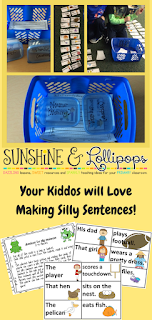I am NOT a certified English Language Learner Teacher, but over the years I have had many ELL students in my first and second grade classrooms. Perhaps because I grew up in a family where my parents spoke 2 languages, I had a keen sense for understanding the difficulties that these children or, more so, parents may experience. I grew up hearing 2 languages but not speaking 2 languages. In fact my paternal grandmother only spoke a few words in English: "Hello Dolly and That's a nice!" So you knew exactly how she would respond to your plea. " Grandmom, I fell and hit my head!" "That's a nice, Dolly!" To say the least it was interesting growing up when grandparents came to visit!
Having taught so many ELL kiddos, I came to realize what works for these learners also support all learners, but there were some special ideas I used to support my English Language Learners in my classroom. I think my grade partner and I became the targeted teachers for ELL students because we just seemed to be able to collaborate with ELL parents in a way that they felt included and active members of the classroom community. Our ELL teachers would "push in" and "pull out " as needed and we were a fine tuned engine chugging along the road of learning together.
So here are some ideas or tips that I have used throughout my 30 +years of teaching to support English Language Learners in my classroom.
1. Label the Classroom
Every year, a few weeks into the school year, I would read the story The Alphabet Tree by Leo Lionni. After we read the story, we came up with a list nouns or people, places and things we noticed around the room, i.e, flag, desk, chair, etc. I would write the words on index cards and children would draw pictures to show the word. Then together we would tape them to the objects around the classroom. Now, this was something I have done forever with my first graders to support environmental print and emergent reading, but I came to realize how important this was for English Language Learners, not only in school, but also to send home. ELL students need reinforcement through visuals to better understand vocabulary. This resource, Labeling the Room for English Language Learners for Home and School, was created to support students at home and at school. Of course we still labeled more than what is included in this resource.2. Using Synonyms, Gestures and Pictures When Presenting Materials
A simple word like bat seems so easy, yet it has a few meanings. This can be so confusing to a child learning to speak English...in fact...English is one of the hardest languages to learn. So when this word is used, it is important to have the class chat about the word, describe the meanings and if you have pictures to support vocabulary use...even better! Think about some of these words: cut, pen, ring, rose, cold, bark, fly...you get the idea....not only is this important for Language Learners, but also for learning vocabulary in general. Using multiple words when giving directions so all children can understand what is meant is another important tip. I am very animated when it comes to speaking so if I say think...I point to my head...when I say listen I pull at my ears...stop...I put my hands up...so these kinds of gestures to support vocabulary understanding came natural to me...YES...I am Italian!! Moving to an area of the classroom or pointing to an object that contains the activities or the book to work with can aid in understanding as well.
Having a Word Wall in the writing station or center that has words that can be represented with pictures to support understanding is ideal. If you do not have the space for a Word Wall, individual sheets with words for writing or Anchor Charts with visuals can also work.
3. Activities, Demonstrations or Games that Use Movement or Modeling to Support UnderstandingLet's face it.
All kids enjoy moving and we all know that research shows that children learn best when movement is incorporated into learning or Brain Breaks are used to break up lessons. Movement when used to demonstrate ideas or concepts can support all learners, but most importantly ELL students. Demonstrating the verb, run, if children see someone running or run themselves, they understand the concept of running. Think how much understanding of language can be accomplished by doing and just how much fun everyone will have.
Having students model directions, rules, expectations and ways in which to use materials are all visuals that can support understanding. Telling is not always a good choice for ELL students as they may not know what you mean, but showing, modeling and/or demonstrating is so much better for all learners.
Visual Schedules with pictures as well as words; either individual schedules or class schedules posted in the front of the classroom are great ways to support ELL kiddos and ALL emergent learners. Visuals, Visuals, Visuals lots of Visuals for expectations, rules directions...everything!
4. When Possible, Bring Parents into your Classroom to Show Expectations Rather Than Sending Notes or Making Phone Calls
Back to School Night is a great time to take a few minutes to show your ELL parents classroom expectations. Use visuals for each idea you are presenting. I used a Power Point Presentation and then showed the actual item in the classroom to support understanding of my classroom structure and student expectations...samples, samples, samples..you can never have too many samples.
If necessary, I actually set a time for ELL parents to stop by and observe the class in action so they had a better understanding of how the class ran...the old saying "Seeing is Believing"...I changed to "Seeing is Understanding!"
5. HOMEWORK Club
Although this is more of a district support, it is well worth mentioning. This program was created by a grant. When you think of sending homework home, it is easy to forget that many times parents of ELL students may not read English... so homework may not get completed correctly. When assigning homework, it might be best to create adapted homework for these children, which use pictures to support understanding. However, this can be difficult. Teachers have enough on their plates and may find it difficult to create adapted homework assignments for ELL kiddos. We used to make our homework easy to complete and scripted with repetition in that you did certain things on certain nights. This made the homework easier to complete. However if you have parents who could not support their children due to language barriers, it still puts a strain on the family and on family time. YES...you could not assign homework and I know there is a lot of controversy surrounding whether or not to have homework at all, but if you district insists on assigning homework...this may be an idea to consider....Homework Club!
We provided this club for any student who needed homework support, but a majority were ELL kiddos! It was an after school program and ran for 3 days each week. We connected with our High School's Community Service Club and students came over after school to help our ELL kiddos with their homework and also reviewed concepts if there were any misunderstandings. Data, that was collected, showed that the younger students made social connections with their helpers, progress with academic concepts and their confidence soared. My grade partner and I administered and oversaw the club.
6. Building Classroom Community where Differences are Celebrated
"Diversity is the One Thing we have in Common"...one of my favorite quotes!
Celebrate differences. During Morning Meetings encourage ELL students to teach your class how to say "Good Morning" in their language and use that as the greeting for the day. During math have the children teach others how to count in their language. If the written form is different, let them explain the differences to allow for understanding. Use good ole' Google to show where each native country is located and maybe have the students or a parent come in to show a bit about their culture and country. Have an "International Day" or a "Heritage Day" and encourage parents to send in foods from their country (as long as your school allows this), These activities are not limited to ELL students.....they are open to all students...everyone comes from somewhere and has different traditions and shares different cultures. These activities will enable your students to feel connected by their differences and feel like active members of the classroom community or culture.
One last comment...One year I had 9 different countries represented in my classroom: Japan, Korea, China, Viet Nam, Pakistan, India, Ireland, Philippines and the United States!!! We had so much fun that year learning about all of these countries, traditions and cultures. ALL students in my classroom shared their heritage!!!
Here are a few resources that support English Language Learners from Sunshine and Lollipops...Click through and Check them out!!
Here is a Free Diversity Poster for you: Free Poster
What tips or ideas can you share that have worked for you with your ELL students? Please share your tried and true ideas in the comment section! Enjoy the rest of your school year!!!



















70% of my students are ELLs. This is SO helpful! Thanks for writing and sharing this!
ReplyDeleteMegan- So glad you liked the post! It is so important to make all students feel included and it is a bit more difficult if there is a language barrier...What I have listed above just really touches the surface, but was very helpful for me when I taught!!! Thanks for your comment!
ReplyDeleteThis would definitely set a more friendly welcome for ELL students. Great advice!
ReplyDeleteI wish you were a my teacher growing learning English. All of your tips are just perfect. I wish more teachers will understand how to help ESL/ELL students, like me. HAAAA... Thanks for sharing that. I'm sure it can totally apply to teaching Chines to non-native Chinese people.
ReplyDeleteThat is so true...these tips can be used in the reverse way for whatever your second language is!!! Thanks for your wonderful comment!!
DeleteKathy, This is an excellent post. As a former teacher of newcomers I might add Small group instruction and social language activities. I can see why you and your partner were the designated ELL classrooms. ❤️❤️❤️
ReplyDeleteThanks for sharing these great tips!
ReplyDeleteThese are terrific tips/reminders! Your classroom must have been a warm & vibrant environment!
ReplyDeleteThese ideas work well for emergent communicators, too, in English ( or their native language). Thanks
ReplyDeleteThank you for your comments. I have very fond memories of my grandparents!!!
ReplyDelete